Gravel suspension forks aren’t about clearing massive jumps, but instead increasing comfort and adding control.
Indeed, the best gravel suspension forks will eliminate vibrations and chatter over rough surfaces and, at speed, absorb high-frequency knocks to keep your handling in check.
These forks are a growing category and there are now several options from big-name suspension brands, including RockShox and Fox.
As well as smoothing out your ride, gravel suspension forks with more travel will help you take on more demanding trails and transform your gravel bike into something a bit like a hardtail mountain bike.
We are beginning to see suspension forks specced on the best gravel bikes and even gravel bikes costing under £2,000. But these forks are typically aftermarket options to be added to a bike.
Our buyer’s guide to gravel suspension forks explains more, including how to fit them and how they may affect your bike's geometry.
Keep reading to find out which forks impressed senior technical editor, Warren Rossiter, who spent 12 months and clocked up 1,000km putting them through their paces.
Best gravel suspension forks 2024
RockShox Rudy XPLR Ultimate

- £779 / $799 / €869 as tested
- Pros: Construction; peerless performance; progressive
- Cons: Needs professional servicing
The RockShox Rudy XPLR Ultimate has been designed and built from the ground up. Its internals are the most impressive of the forks in our recent group test, with all-alloy polished and anodised parts, and quality construction overall.
Setting up the RockShox gravel fork is quite simple. You only have to adjust the air-spring pressure and rebound damping. This is done using a small 2.5mm Allen key.
The sensitive initial stroke absorbs the impact on your bar from poor roads, dry trails or golfball-sized gravel and is far superior to relying on larger-volume tyres.
There’s also a significant improvement in control, with the fork’s supple, swift movement meaning you maintain tyre contact with the ground.
If you’re running a tubeless setup, the fork’s cushioning enables you to run lower pressures.
The compression ramps up progressively, so the fork never ‘bottoms out’ on big hits, despite having only 40mm of travel. It also makes the Rudy one of the best for riding out of the saddle, but it still has an almost rigid feel when grinding up the steepest climbs.
Even if some of its rivals may edge ahead in single elements, the Rudy offers the best combination of performance, handling, weight and price.
Fox 32 TC Factory

- £1,000 / $949 as tested
- Pros: Easy to set up; stiff; plush; big-hit response
- Cons: Doesn’t come cheap; best serviced professionally
The Fox 32 TC Factory’s 50mm of travel makes it one of the longer options available and with that comes Fox’s signature plush smoothness.
This premium Fox gravel fork gets the slick gold Kashima coating on the 32mm stanchions, seen on Fox’s mountain bike forks. There are also three settings – open, medium and firm – and rebound adjustment on the lower leg.
On gravel roads, the fork is supple and smooths vibrations with ease. This top-end Factory model offers on-the-fly adjustment within the ‘open’ mode, via a second dial inside the compression dial.
While there’s no full lockout, the 32 TC in its firm setting avoids any bobbing or diving when you’re climbing or sprinting. The Fox also conquers jarring hits with composure.
It’s impressively light for a longer-travel fork weighing 1,320g, which is only 20g more than the RockShox, despite having 10mm more travel.
The lower leg’s hollowed-out rear is a clever weight-saving touch, but it means the bolts need a special tool for maintenance. The finish throughout is exemplary.
This is a brilliant option if you can swallow the expense and are looking for a fork to take on predominantly singletrack and more technical terrain.
KS GTC
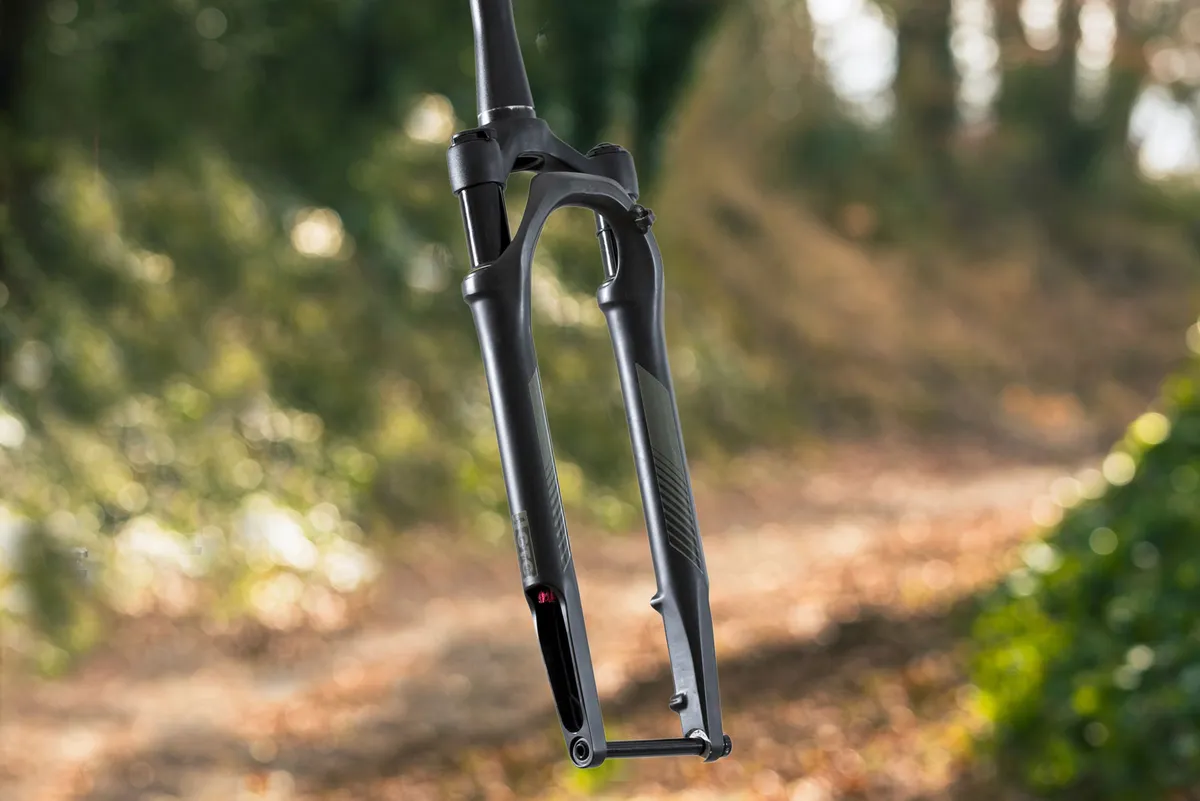
- £599.99 / $600 as tested
- Pros: Well priced and well made; great on chattery surfaces
- Cons: Lacks precision on rebound adjustment
The KS GTC is an excellent budget option with 40mm of travel. It’s well put-together and has great-quality soft seals, which you don’t normally find on lower-priced forks.
From the first outing, it was clear this fork is all about removing chatter and improving comfort. Despite having the smallest-diameter stanchions on test, it was one of the stiffest forks, thanks to the thickness of the material used. This also accounts for it being one of the heaviest at 1,470g, even though it features carbon lowers and brake arch.
The rebound adjustment isn’t as good as others. It doesn’t have any clicks within the dial and takes a lot of turns to induce any real change when you want to increase the rebound speed.
On medium-to-bigger hits, the fork can make it feel as if you’re riding through oil. The fork didn't have any increase in stiction, but its action is relatively slow.
Cleverly, the fork ramped up well through its progression, so it never topped or bottomed out.
Overall, the KS is very well made and performs well enough to compete with more premium forks. It’s a decent jack of all trades, which is what you want from a gravel fork.
Also consider…
We haven’t included the following forks in our pick of the best gravel suspension forks because they scored fewer than four stars in testing. However, they may still tick the right boxes for you.
Cannondale Oliver Lefty
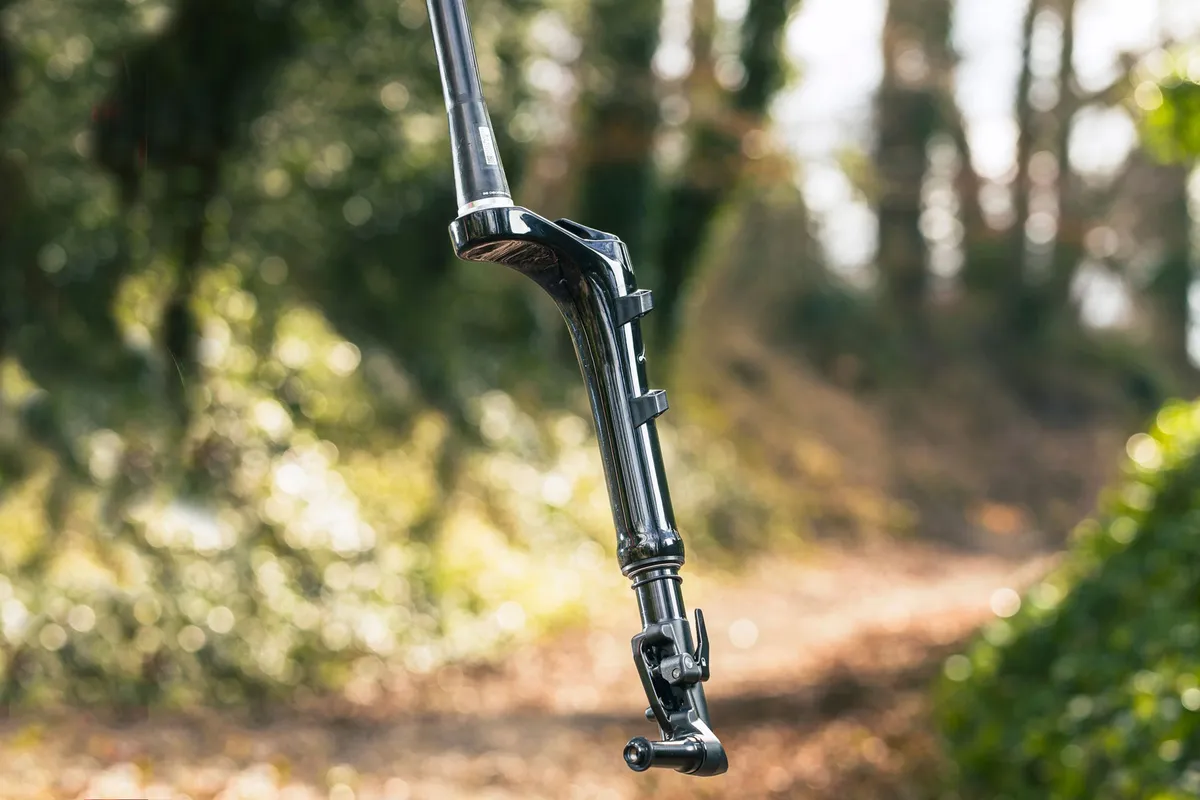
- £1,400 / $1,575 (plus wheel) as tested
- Pros: Class-leading stiffness; great response to bumps
- Cons: Needs pro servicing and dedicated wheel
The Cannondale Oliver Lefty is a single-sided inverted suspension fork. It's an impressive technical achievement combining a spring and damper in a single leg.
The Lefty isolates rebound damping and compression, making the fork resistant to bobbing when sprinting or climbing out of the saddle, despite its impressive fast-bump response and plush action.
There’s also a lockout on top of the leg should you want it super-stiff for riding on roads, and this is designed to blow off if you hit an obstacle.
On light gravel roads, the Lefty feels super-smooth. On technical terrain, the fork performs impressively, even with its short 30mm of travel. The stroke ramps up progressively, never topping out or clunking at either end of its travel.
At 55mm, the Lefty has more offset than all its rivals, so it will change the front end of some bikes.
The downside is its price and the need for a dedicated front wheel. It’s also a rather complex fork, and while keeping it clean will help, the service schedule means extra expense.
Tester Warren would recommend the Lefty for pure performance, but he’d rather buy it as part of a complete bike.
Lauf Grit SL
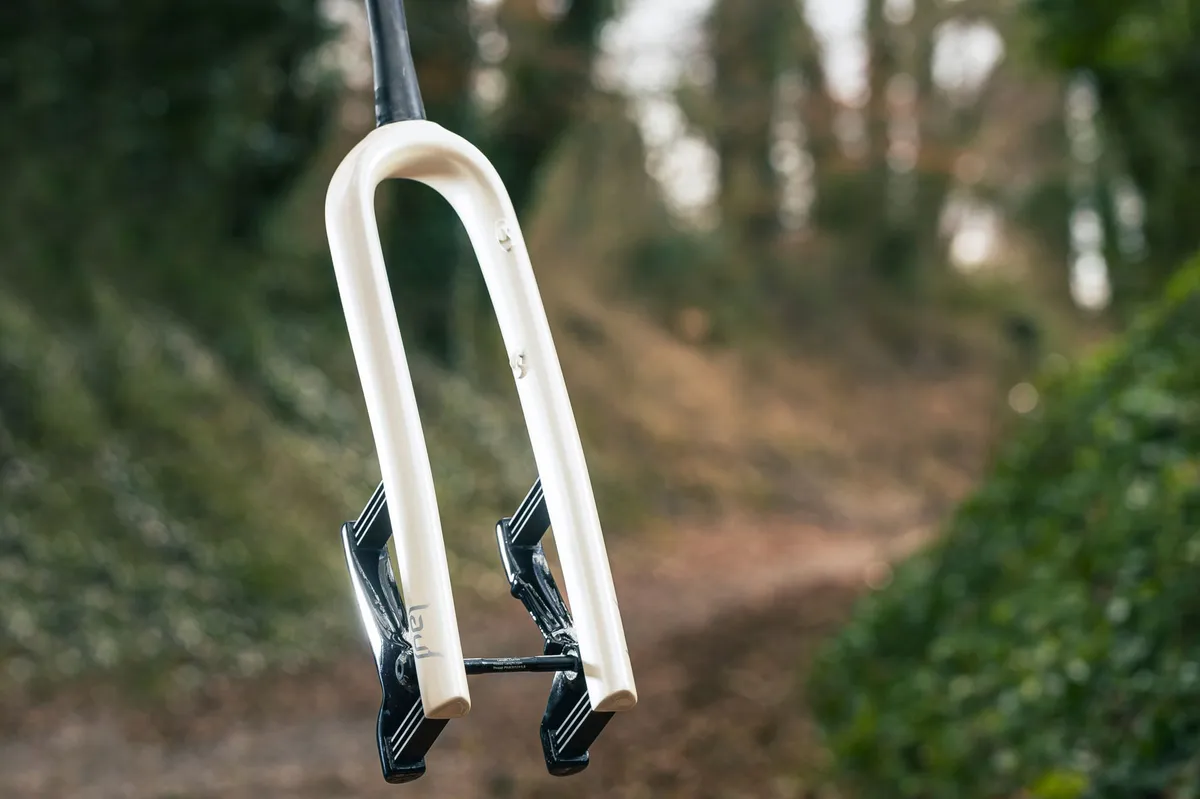
- £900 / $990 as tested
- Pros: Excellent vibration damping; low maintenance; lightweight
- Cons: Lacks control on technical trails
The Lauf Grit SL looks completely different from a telescopic gravel suspension fork, with its unique springs suspending the fork dropout and offering 30mm of travel.
This design also has no internal moving parts, making it the easiest suspension fork to maintain, but that means you can’t tune its performance.
Positively, it’s the lightest suspension fork available, weighing only around 400g more than a typical rigid carbon gravel fork.
On gravel roads and scarred tarmac, the smooth nature of the leaf springs working in unison is a dream for upper-body comfort and endurance riding.
The Grit SL’s constant damping works best when you’re seated in the drops or on the hoods. It suffers when you get out of the saddle, though, with the lack of rebound control and lockout meaning the fork bobs.
On rooty or rocky descents, the fork can feel choppy with the rebound of the leaf springs becoming overwhelmed. However, this third-generation SL does a much better job of coping with higher speeds than earlier iterations.
The Grit SL is all the fork you’ll ever need for fatiguing chatter and smoothing out rough surfaces. But look elsewhere for a fork to ride techy, lumpy singletrack trails.
MRP Baxter

- £950 as tested
- Pros: Highly customisable; well built; big-hit response
- Cons: Heavy
The MRP Baxter fork is available with either 60mm or 40mm travel, although the fork can be adjusted with the included volume spacers if you change your mind.
Set up with 60mm of travel, the axle-to-crown length is increased to 456mm, providing clearance for 50mm gravel tyres.
Warren could set up the fork with more sag than its rivals, resulting in a fork that outstrips the rest on bigger hits and traversing rooty, rutted forest terrain.
The downside is it didn’t soak up smaller bumps so well, and it didn’t smooth chatter as well as other forks. After adding a spacer to reduce the Baxter’s travel to 40mm, its chatter response and speed improved dramatically.
The Baxter is heavier than its rivals at 1,680g, but it handles its heft well. The fork has tons of stiffness to keep the handling tight and its stroke is silky smooth. It’s an excellent companion for twisty technical trails, with its big-bump prowess coming to the fore.
There are three settings, which means the fork can be adjusted for different surfaces. Warren found himself using the three-position control a lot.
How I tested the best gravel suspension forks
Warren Rossiter – senior technical editor
As senior technical editor at BikeRadar and Cycling Plus I’ve followed the development of gravel riding since its inception.
I first tested a thoroughbred gravel bike in the early 2010s and since then I reckon I’ve tested over 200 gravel bikes, alongside countless gravel accessories and components.
Gravel suspension is one of the latest developments in gravel tech, and I’ve been testing the forks in this group test since March 2023.
It’s hard to put a definitive number on it, but I’ve ridden roughly 1,000km using the forks included here. Every fork was ridden on gravel tracks, towpaths and woodland singletracks with rocks and roots.
Above all, I was looking to find which forks offered comfort and control. But I was also looking to see how well the forks negated tiring vibrations, softened the edges of jolting rocks and roots, and handled bigger hits. They needed to maintain composure on climbs and tarmac roads, too.
To understand how these forks perform, I fitted them to several gravel bikes, including a Cannondale Topstone Lab 71, Lauf Seigla and Kinesis Tripster ATR V3.
But I didn’t do this single-handedly. I had my riding buddies trying out the forks to get a second opinion and confirm my findings. I also took them to Full Factory Suspension where Finlay Paton stripped each fork down and offered his expert opinion on its design and build.
Best gravel suspension forks buyer’s guide
Why should you use a gravel suspension fork?

The best gravel suspension forks will help make your ride smoother and potentially minimise fatigue.
Uneven surfaces can deflect the front tyre, which puts forces into the bar, snapping it left and right, and affecting your ability to maintain speed and navigate technical terrain. Continual vibrations also lead to premature fatigue in your upper body.
If you can’t hold the handlebar because your arms are pumped and your shoulders ache, you’ll have to stop riding.
How much travel does a gravel suspension fork have?
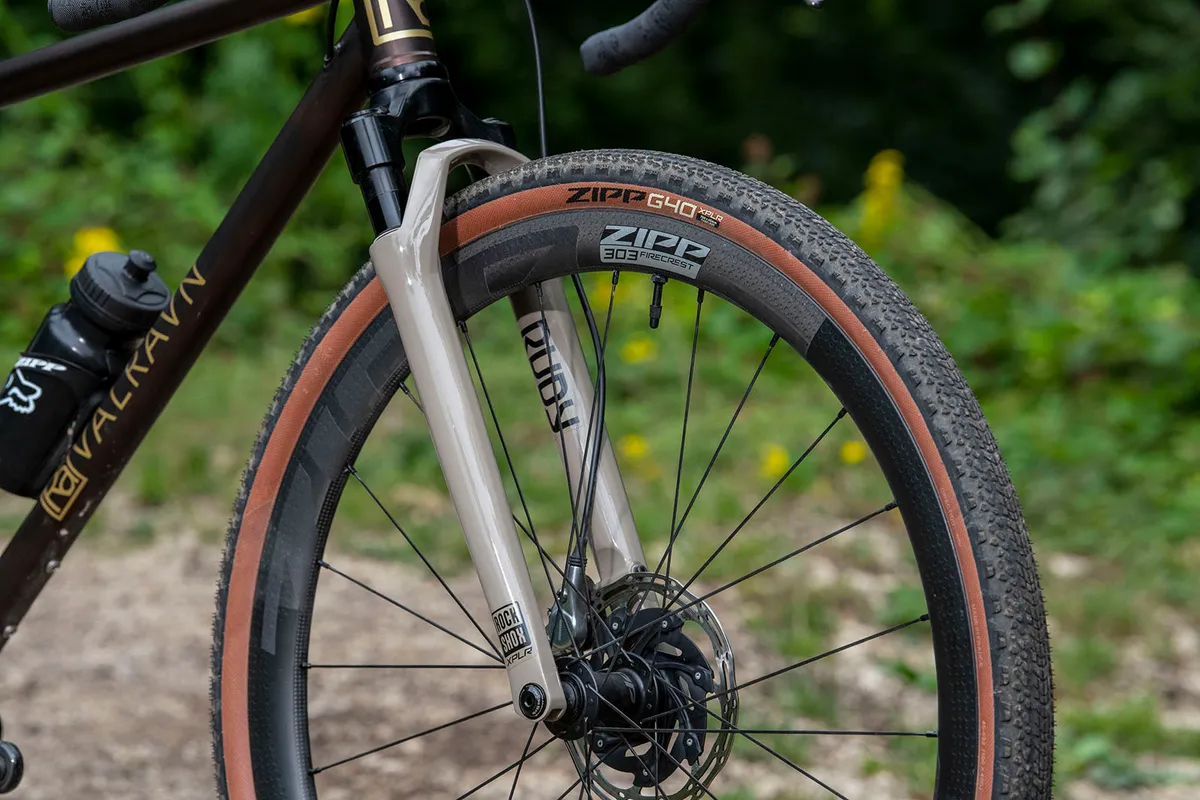
Suspension gravel forks typically have between 30mm and 60mm of travel.
This is significantly less than mountain bike suspension forks, which can range from 100mm to 200mm of travel.
But the limited travel on gravel suspension forks is for good reason. Suspension on gravel bikes isn’t about clearing jumps, it’s about adding comfort and control.
How easy is it to install a gravel bike suspension fork?
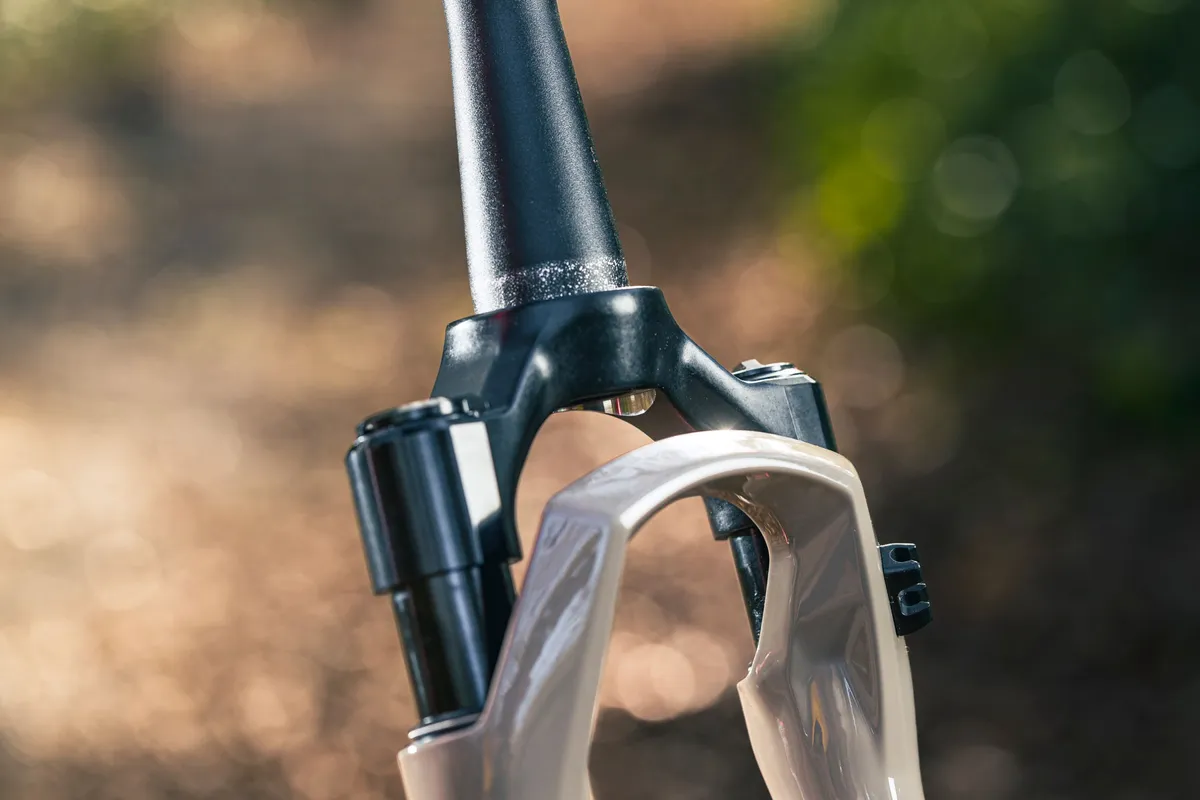
Fitting a gravel suspension fork is fairly straightforward, though ensure your frame is compatible.
All our test forks use a tapered steerer (widening from 11⁄4in at the top to 1.5in at the bottom).
Most rigid gravel forks measure 395mm to 405mm from axle to crown (the junction where the two ‘legs’ meet).
The average gravel suspension fork is 435mm, so even accounting for 10-15mm of sag, the stack will be higher.
Some modern gravel bike frames are suspension-corrected, but on older frames a suspension fork will add to handlebar height and slacken the head angle, changing the bike’s handling.
Suspension terminology explained
While mountain bikers will know suspension tech and terminology like the back of their hand, gravel riders may not be so familiar.
This list explains the key suspension terminology you need to know.
- Damping: the process of controlling a spring (using a hydraulic or mechanical system) as it compresses and rebounds.
- Rebound damping: This controls how fast or slow a fork can extend (rebound) after being compressed when hitting a bump or due to rider input (compression damping controls compression speed).
- Binding: Friction caused by flex in the system that makes it harder for the fork to compress (when the narrow upper stanchions telescope into the wider lower legs).
- Stiction: Friction caused by the fork seals, dampers, bushings, lack of lubrication etc, can make a fork feel harder to compress and/or slower to rebound.
- Lockout: Controlled by a lever on the fork or via a bar-mounted
- remote, the lockout increases the compression damping to where the fork will hardly (if at all) move through its travel.
- Blow-off valve: This unlocks a locked-out fork if it hits a large bump: handy when you forget to open it or unexpectedly meet a rough section of trail.
- Progression: How much the suspension firms up towards the end of the stroke, when the spring rate – the amount by which the spring force increases per unit increase in travel – increases near the end of the travel.
- Fork rake: The distance of the front axle in front of the steering axis – an imaginary line down the midpoint of the steerer tube.
How else can you make gravel bikes more comfortable?
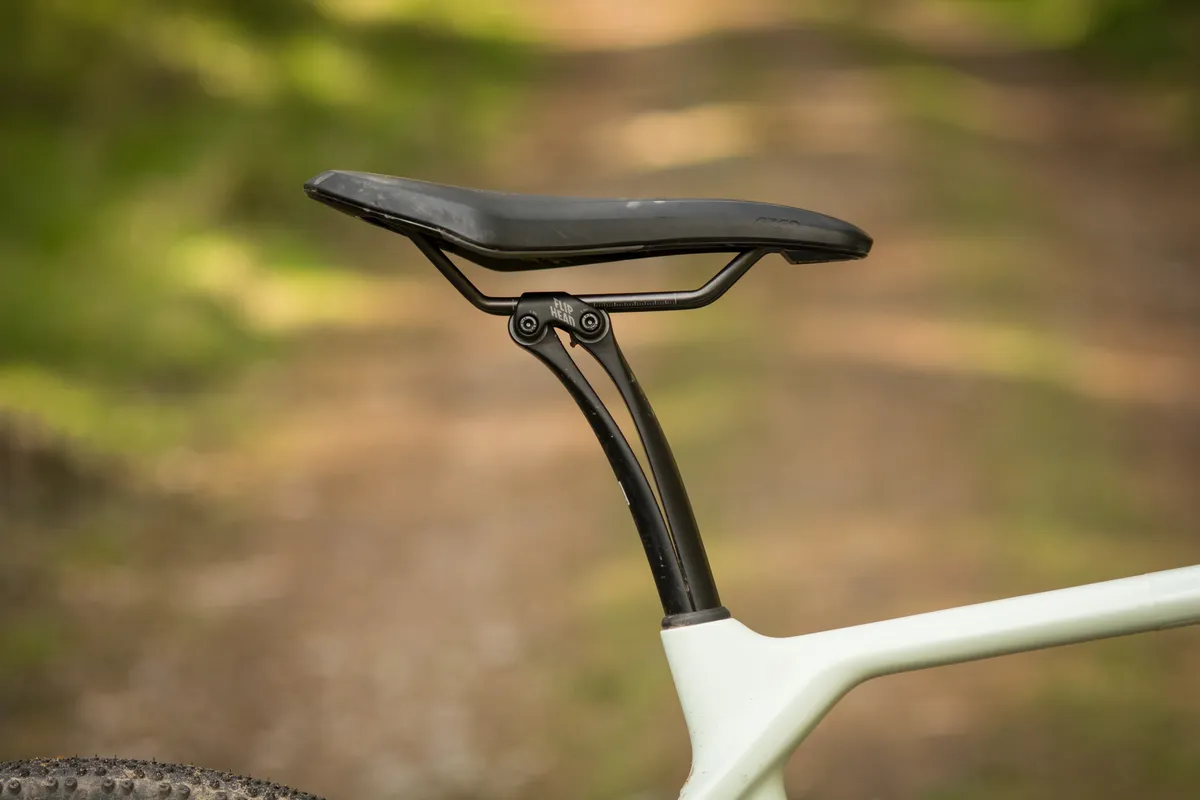
The best gravel suspension forks are a pricey investment, but there are other ways to make your gravel bike a bit more comfortable.
There are other cheaper forms of gravel suspension to consider. One option is to install a suspension seatpost to absorb vibrations while in the saddle.
A less common option is a suspension stem. The Redshift Shockstop Stem is one example that scored well in testing. It absorbs bumps via interchangeable internal elastomers.
Installing wider gravel bike tyres is the easiest way to bring a bit more cushioning to your ride. You’ll have to check the maximum tyre clearance on your bike, but many of the latest gravel bikes can fit tyres wider than 50mm.
You can also optimise your gravel tyre pressure to minimise vibrations.

